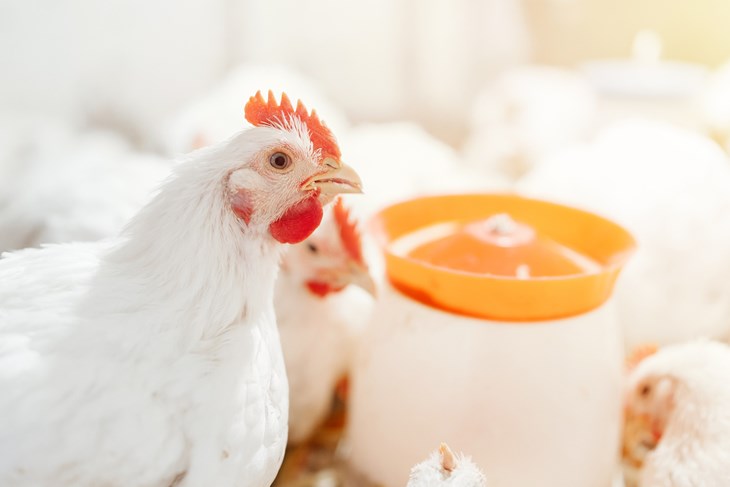Beyond stocking density: what really constitutes higher welfare for chickens?
09/04/2024

By: Dr Tracey Jones, Global Director of Food Business, Compassion in World Farming
Recently, there has been a promising move in the UK retail sector to give chickens reared for meat more space to live. Major supermarkets like Sainsbury’s, Morrisons, Co-op and Lidl have all made commitments on own-brand fresh chicken to reduce the stocking density of their birds to 30kg/m2.
This traction is a positive step forward when combined with natural light and enrichments, improving living conditions for chickens, and helping to shift the market. It is certainly well overdue. For many years, organisations like ours have been advocating for reduced stocking densities through initiatives like our Good Chicken Award. Sainsbury’s, for instance, was among the first to commit to lower stocking densities back in 2010. However, it later backtracked on this commitment in 2018. Co-op also received accolades for similar efforts in 2010, but reneged on its promise to reduce the stocking density for its broiler chickens in 2012. These regressive steps have finally been corrected over a decade later – but there is still more that needs be done before retailers can truly start talking about ‘higher welfare’ as their baseline standard.
Space provision is only part of the solution
The issue of welfare goes beyond stocking density. While retailers claim that providing 20% more space means happier, healthier chickens, the reality is more nuanced. Space provision is only one element in the equation. And this can be confusing for customers who are presented with a variety of marketing initiatives claiming higher welfare on space provision and enrichments alone.
Higher welfare requires a holistic approach that encompasses all the most pressing welfare concerns for broiler chickens, as outlined in the Better Chicken Commitment (BCC). The BCC is a package of science-based criteria, and ALL the criteria need to be implemented to significantly improve the lives of chickens reared for meat. One of the most important requirements of the BCC is moving to slower growing breeds that have been shown to have better welfare outcomes and lead healthier, happier lives.
Fast-growing breeds don’t equate to higher welfare
Broiler chickens have been selected for high growth rate, feed efficiency and large breast meat yield. Compared to 50 years ago, conventional broiler chickens grow more than four times as fast and have a breast that is 80% bigger. Weighed down by their unnaturally fast-growing bodies, many of these birds have poor functioning immune systems, and suffer from heart defects, breast muscle inflammatory diseases, and high rates of foot and hock lesions. Fast-growing breeds also often have poor walking ability and high rates of lameness. They spend most of their time (85%) sitting doing nothing, instead of behaving like chickens who naturally like to perch, peck, forage, scratch and play. Fast-growing birds are physically unable to take full advantage of the extra space provided.
Of the 1.15 billion chickens reared for meat in the UK in 2020, around 90% of them were fast-growing breeds. Moving to slower growing birds is vital if we are to give chickens a better quality of life. Without this, supermarkets simply can’t talk about their chicken being higher welfare.
The urgent need for meaningful change
In the UK, the major supermarkets can help drive the market shift towards higher welfare systems for ALL chickens. They have the power and responsibility to bring about this real, meaningful change – and owe it to the chickens in their care and to their customers who increasingly expect animal welfare to be at the heart of their businesses. The progress we are starting to see - the recognition that standards need to improve - is encouraging, but more needs to be done.
Consumers can buy higher welfare chicken at the moment. They can look out for free-range and organic options in all major supermarkets. If shoppers want to buy BCC-compliant indoor chicken, they should look for RSPCA Assured or Red Tractor Enhanced Welfare (not standard Red Tractor) certification labels. It is also available at M&S – where all its fresh chicken meets BCC standards - or in two supermarkets that offer BCC-compliant ranges: Tesco’s ‘Room to Roam’ and Morrisons’ ‘Space to Roam’, but these only make up a small proportion of their full chicken offer.
If retailers are serious about raising the welfare bar, instead of piecemeal pledges on elements that suit them, they need to make the wholehearted decision to sign up to the Better Chicken Commitment. Reducing stocking density without a commitment to key requirements such as breed change will not deliver the complete welfare impact.
Only by delivering on all the BCC criteria – moving to slower growing breeds, providing more space and enrichments, using more humane slaughter methods and auditing/reporting to ensure full compliance – will their chickens experience real benefits. Only then can they truly speak of higher welfare. We have seen this commitment from M&S and Waitrose. But Aldi, Asda, Co-op, Lidl, Morrisons, Sainsbury’s and Tesco all need to be equally ambitious and focused.
Lower welfare chicken, particularly under the marketing guise of ‘higher welfare’, shouldn’t be an option on the shelves. We can – and must - do better than that.